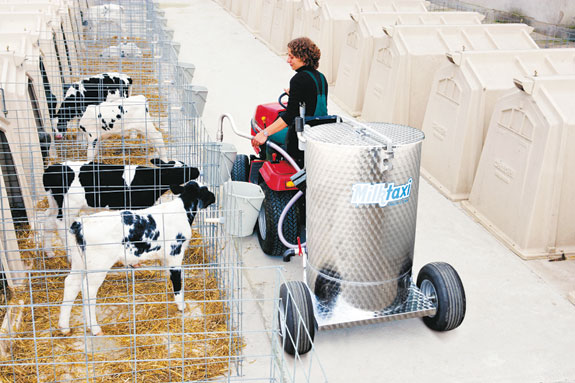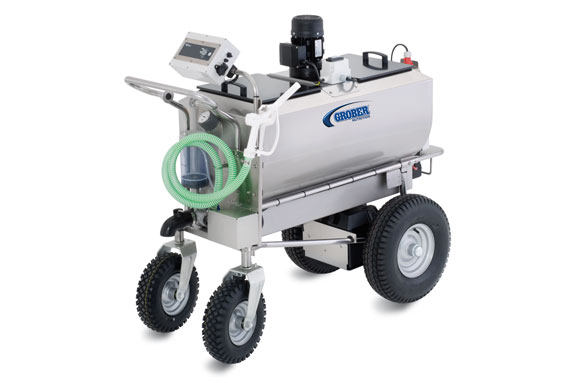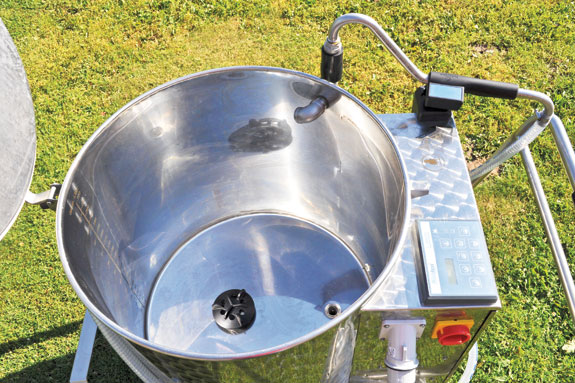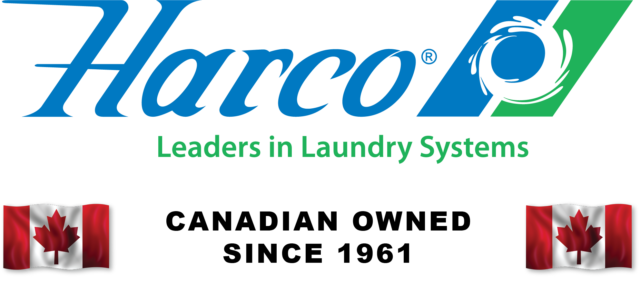There is no wonder there has been a movement to automate the calf feeding process – so much so that week-old calves kept in group housing can now literally feed themselves. Yet there are a number of farms that are not set up for group housing, can’t afford the computerized feeding systems or simply prefer individual housing.
Luckily for them, two companies have developed a new style of feeding system that easily transports bulk quantities of milk or milk replacer out to the calves.

Holm & Laue introduced the Milk Taxi in Canada two years ago, while Grober Nutrition and Förster-Technik are coming to the market with the Milk Mobile.
These units can agitate, pasteurize, transport and deliver a precision dose to hungry calves, saving both time and labour.
According to Andy Stahl, time spent on calf feeding has been cut in half from 45 minutes to an hour down to just 15 to 20 minutes.
He has been using the 180-litre Milk Mobile for nearly four months on his farm near Ruthilda in western Saskatchewan.
He milks 350 cows, raises 500 beef cattle and manages 30,000 acres. At any given time he is feeding milk to 40 calves.
Both units are made of stainless steel for easy cleaning, which is said to take about 5 to 15 minutes.

They also are equipped with large rugged tires to conquer most terrains.
“We like that we can move it around,” Martyn Mulder says. “You can take it anywhere.”
Mulder uses the Milk Taxi on his family farm in Lakeside, Ontario. They milk 350 cows and run 1,200 acres.
“We went to feeding whole milk and needed a way to transfer the milk to the calf barn,” he says.
Thomas Haerle purchased the Milk Mobile a couple of months ago for his 100-cow family farm in St. Isidore, Ontario.
Until now, he had been feeding whole milk, but with additional quota to fill for the summer, he switched to milk replacer.
With the change, he wanted the proper piece of equipment to agitate the milk because his previous milk mixer was worn out.
“Now, we push the Milk Mobile in front of the calves and feed as we go. We don’t have to walk back and forth,” Haerle says, noting it’s easiest on his mother, who does 95 percent of the calf feeding.

Inside the tank, there is a metered scale to measure the amount of milk or water to add. An internal thermometer feeds the temperature to an outside reader for easy monitoring.
Stahl says his calves are drinking better now that they are fed milk at a consistent temperature.
“It has been working great for us,” he adds.
Stahl fills the tank with 40°C water, adds the milk replacer and by the time it is mixed, the mixture is at body temperature and ready to feed.
He figures with his previous bucket method, the temperature varied by 5 or 8 degrees each feeding.
Now, he reports his calves are gaining more weight, have a nicer hair coat and are even being weaned 1½ to two weeks earlier with this new feeding system.
“You could see the changes within a week or two,” Stahl says.
He also notes a change in his bottom line. Less milk replacer is purchased, thanks to the earlier weaning time. “On 40 calves, that’s quite a bit of money,” he says.
The feeding units deliver milk to the buckets calfside through a dosing pump. Operators are able to select the dosage to be fed; then, with the push of a button, the exact amount is delivered to the calf.
“It’s a doser with push control. You don’t have to hold a trigger,” says Jan Ziemerink, manager of automation services for Grober Nutrition and Förster-Technik.
The accuracy of the amount is another reason why producers like these technologies.
“We can walk by the calf hutches and put the right amount of milk in every time,” says Marius VanWely, who purchased a Milk Taxi from Norwell Dairy Systems because he wanted to incorporate pasteurizing into his farm’s calf feeding program.
Farming near Woodstock, Ontario, VanWely says he has also used the unit with milk replacer and that it mixes that nicely too.
Soon after purchasing the unit, Haerle discovered he had been overfeeding his calves. They had just poured milk into the pails until they felt there was enough for the calf. “With the metering system, we noticed we were overfeeding,” he says. Haerle figures the unit will pay for itself in cost-savings from overfeeding.
For the most part the units are quite similar, but they do have their differences.
Milk Mobile
The Milk Mobile is available as 100-litre or 180-litre horizontal tanks and does not have the ability to pasteurize or drive itself at this time, although the company is looking to introduce a motorized unit in the next six months, as well as a 250-litre model, Ziemerink reports.
The battery-operated dosing pump is adjusted with a dial and can be set in .5-litre increments from .5 to 5 litres.
The 100-litre unit sells for $4,600 and 180-litre for $5,300. There may be an additional charge depending on freight.
Milk Taxi
According to Tom Olsen, national sales manager at Calf-Star, the Milk Taxi can also cool, heat and pasteurize milk. For use exclusively for milk replacer, the unit can be purchased without the pasteurizer.
It is available in the following sizes: 80 litres, 120 litres, 200 litres and 250 litres. There are also three different modes of transportation: push, electronic drive or pull-behind.
The computerized dosing pump allows any measurement to be set from .5 to 11 litres.
The cost ranges from $9,500 to $12,000, depending on options.
Whichever option is chosen, the producers agree there is less labour, faster feeding and more consistency.
“It works awesome,” Stahl says. “I just love it.” PD
For more information on the Milk Taxi, contact Tom Olsen at Calf-Star at (608) 883-6533. To learn more about the Milk Mobile, contact Grober Nutrition at (800) 265-7863 or give it a trial run at Canada’s Outdoor Farm Show Sept. 13-15 in Woodstock, Ontario.
PHOTOS:
FIRST & SECOND: A metered dosing pump lets calf feeders walk or drive by calf pens and deposit the right amount of milk every time. The Milk Taxi is shown here. Photo courtesy of Calf-Star.
THIRD: Rugged tires on the Milk Mobile allow it to navigate over dirt, grass, gravel or cement. Photo courtesy of Grober Nutrition.
FORTH: Stainless steel tanks, like the one shown here on the Milk Taxi, make for easy cleaning of the feeding unit. Photo courtesy of Calf-Star.
YOUR RESULTS
Would you benefit from this type of feeding system?
The following checklist can be used to determine if this new technology might be a fit for your operation.
1. Do you milk 700 cows or less?
2. Do you raise your replacement calves through weaning?
3. Are they housed in individual pens?
4. Are you tired of carrying pails of milk?
5. Would you like to deliver a precise amount of milk at each feeding?
6. Are you looking to obtain a more consistent mix of milk replacer?
7. Is feeding milk at the same temperature important to you?
If you answered yes to five or more of these questions, this technology may be one for you to consider.









